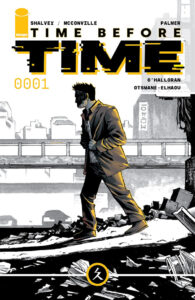Oscar has one job, a unique job. The kind of job where one could pay their life savings to travel back in time to have a better life than the present. 
For Oscar, he’s done this job enough to know that in the year 2140, the present is crap. If he can’t pay off his debt to the organization known as the Syndicate, what else is there to do? If Oscar can’t have a future in the present, what is he willing to do to change it?
Declan Shalvey and Rory McConville introduces readers to a world where tomorrow is never promised, and yesterday never fades. Shalvey and McConville immediately hit the ground running with interesting characters and a setup that is both fictional yet identifiable to the current world that the reader resides in. Some of the writing hits close to home in regards to the protagonist Tatsuo. In a world where poverty just continues to rise, and the environmental conditions continue to worsen, it’s easy to see why Tatsuo and his friend Oscar commit to the decisions that they make. Tatsuo’s frustrations with paying off his debts in order to have some semblance of an unchained life is relatable. Anyone that experiences the hardships of the COVID pandemic, losing their jobs, paying off student debts, or being overworked for little pay is something that anyone can identify with, especially with Tatsuo’s desire to be free from his depressive routine. His plight is understandable enough to want to escape from, and that’s what makes this book so captivating. Given that time travel is involved, there has to be consequences right? It’s a grand concept and grand world where time is truly of the essence, with every decision that Tatsuo makes, Shalvey and McConville ensure that the reader will feel the pressure that is applied to Tatsuo.
Palmer’s art truly cements the aesthetic and tone of Time Before Time. It really brings Shalvey’s writing to life in a manner that reinforces the concepts, and actions that are occurring throughout the book. Palmer’s layouts in addition to Halloran’s color work are wonderfully drawn, giving each panel a different perspective and lens that give the book a visual flavor that would perfectly work for film. There’s aesthetic elements of this book that make it the perfect love child of Blade Runner, and other sci-fi films of the genre, with a little bit of David Fincher to boot. Hassan does an exemplary job with the lettering, giving it a sense of character that feels unique to each character’s speech and actions. Whether it’s an exchange between characters or subtle movements that are depicted, Hassan shows exactly why he does what he does best as a letterer and as an educator in the craft of lettering.
This series holds a lot of promise given the worthy investment and time that it immediately provides for readers. If you love films such as Blade Runner, Looper, and crime drama’s of the sort, this book scratches that itch. It’s a great combination of two genres that is personal in scope, but grand in scale. And given the page count of this book, it’s worth picking up and adding to your pull list for new comic book day.

